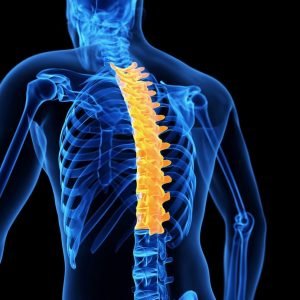Compression Fractures of the Spine
What are Compression Fractures of the Spine?
As we get older, our bones thin and our bone strength decreases. Osteoporosis is a disease in which bones become very weak and more likely to break. It often develops unnoticed over many years, with no symptoms or discomfort until a bone breaks.

Fractures caused by osteoporosis most often occur in the spine. These spinal fractures — called vertebral compression fractures — occur in nearly 700,000 patients each year. They are almost twice as common as other fractures typically linked to osteoporosis, such as broken hips and wrists.
Not all vertebral compression fractures are due to osteoporosis. But when the disease is involved, a vertebral compression fracture is often a patient’s first sign of a weakened skeleton from osteoporosis.
Causes
When the small bones of the spine (vertebrae) weaken from osteoporosis, they can narrow or shrink. This can lead to a rounded back, a hump, or a “bent forward” look to the spine. Many people with osteoporosis also note that they are getting shorter over time.
The weakened vertebrae are at a high risk for fracture. A vertebral compression fracture occurs when too much pressure is placed on a weakened vertebra, and the front of it cracks and loses height. Sometimes the cause of compression fractures of the spine is a fall, although people with osteoporosis can suffer a fracture even when doing everyday things, such as reaching, twisting, coughing, and sneezing.
Symptoms of Compression Fractures of the Spine
The symptom of compression fractures of the spine is back pain. The pain typically occurs near the break itself. Vertebral compression fractures most commonly occur near the waistline, as well as slightly above it (mid-chest) or below it (lower back).
The pain often gets worse with standing or sitting for a period of time, and is often relieved by rest or lying down. Although the pain may move to other areas of the body (for example, into the abdomen or down the legs), this is uncommon.
Treatment
Nonsurgical Treatment
Most people who suffer a vertebral compression fracture get better within 6 to 8 weeks without specific treatment to repair the fracture. Simple measures, such as a short period of rest and limited use of pain medications, are often all that is prescribed. In some cases, patients are instructed to wear a brace to restrict movement and allow the vertebral compression fracture to heal.
If your doctor has also diagnosed osteoporosis, you are at an increased risk for additional vertebral compression fractures and other fractures, such as to the hip and wrist. Your doctor will address treatments for bone density loss during this time.
Surgical Treatment
If you have severe pain that does not respond to initial treatment measures, then surgery may be considered.
In the past, the only surgical options available to patients with a vertebral compression fracture involved extensive procedures. Today, vertebral augmentation procedures offer a minimally invasive alternative.
The two types of vertebral augmentation methods available are kyphoplasty and vertebroplasty. The best candidates for these procedures are patients who suffer severe pain from recent vertebral compression fractures. If you are a candidate for vertebroplasty or kyphoplasty, your surgeon will discuss which one may be better for you based on the type of vertebral compression fracture you have.
- Kyphoplasty: In a kyphoplasty, a small device called a balloon tamp is inserted into the fractured vertebra. The balloon tamp is inflated from within the vertebra, which restores the height and shape of the vertebral body. When the balloon tamp is removed, it leaves a cavity that is filled with a special bone cement that strengthens the vertebra.
- Vertebroplasty: Vertebroplasty is a technique similar to kyphoplasty, but a balloon tamp is not used to create a space for the cement. Instead, the cement is injected directly into the narrowed vertebra.
 Fractures caused by osteoporosis most often occur in the spine. These spinal fractures — called vertebral compression fractures — occur in nearly 700,000 patients each year. They are almost twice as common as other fractures typically linked to osteoporosis, such as broken hips and wrists.
Not all vertebral compression fractures are due to osteoporosis. But when the disease is involved, a vertebral compression fracture is often a patient’s first sign of a weakened skeleton from osteoporosis.
Fractures caused by osteoporosis most often occur in the spine. These spinal fractures — called vertebral compression fractures — occur in nearly 700,000 patients each year. They are almost twice as common as other fractures typically linked to osteoporosis, such as broken hips and wrists.
Not all vertebral compression fractures are due to osteoporosis. But when the disease is involved, a vertebral compression fracture is often a patient’s first sign of a weakened skeleton from osteoporosis.

